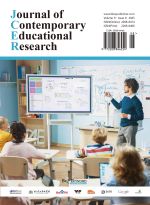Abstract
International student enrollment has rapidly grown in China, positioning transnational education as a significant component of the country’s higher education system. So our study investigates an innovative teaching approach that combines the Knowing-Understanding-Doing (KUD) framework with the BOPPPS pedagogical model (which includes the Bridge-in, Objective, Pre-assessment, Participatory Learning, Post-assessment, and Summary components), with specific application to undergraduate mathematics teaching for international students at a Chinese university. Taking Calculus 1 as a case study, our study evaluates the implementation efficacy of this integrated approach. The findings offer valuable insights for those seeking to enhance the quality and effectiveness of their teaching methodologies in culturally diverse undergraduate mathematics classrooms.
References
Matera C, Imai T, Pinzi S, 2018, Do You Think Like Me? Perceived Concordance Concerning Contact and Culture Maintenance on International Students’ Intentions for Contact With the Host-Society. International Journal of Intercultural Relations, 63: 27–37.
Li Z, Heath M, Jackson A, et al., 2017, Acculturation Experiences of Chinese International Students Who Attend American Universities. Professional Psychology: Research & Practice, 48(1): 11–21.
Sumer S, Poyrazli S, Grahame K, 2008, Predictors of Depression and Anxiety Among International Students. Journal of Counseling & Development, 86(4): 429–437.
Campbell J, Li M, 2008, Asian Students’ Voices: An Empirical Study of Asian Students’ Learning Experiences at a New Zealand University. Journal of Studies in International Education, 12(4): 375–396.
Williams L, Johnson J, 2011, Why Can’t We Be Friends?: Multicultural Attitudes and Friendships With International Students. International Journal of Intercultural Relations, 35(1): 41–48.
Poyrazli S, Lopez M, 2007, An Exploratory Study of Perceived Discrimination and Homesickness: A Comparison of International Students and American Students. The Journal of Psychology, 141(3): 263–280.
Dai K, Elliot D, 2022, ‘Shi Men’ as Key Doctoral Practice: Understanding International Doctoral Students’ Learning Communities and Research Culture in China. Oxford Review of Education, 48(6): 1–16.
Ma J, Sun C, Wang Y, 2022, The Mediating Role of Learning Engagement on Learning Gains of International Students in Chinese Higher Education Institutions – Based on a Multi-Cohort Analysis. Sustainability, 14: 14052.
Gao X, Hua Z, 2021, Experiencing Chinese Education: Learning of Language and Culture by International Students in Chinese Universities. Language, Culture and Curriculum, 34: 353–359.
Hu Y, Dai K, 2021, Foreign-Born Chinese Students Learning in China: (Re)Shaping Intercultural Identity in Higher Education Institution. International Journal of Intercultural Relations, 80: 89–98.
Ma J, Wen Q, 2018, Understanding International Students’ In-Class Learning Experiences in Chinese Higher Education Institutions. Higher Education Research & Development, 37(6): 1186–1200.
Lu X, Dong F, Zhao J, et al., 2019, Research on Advanced Mathematics Teaching for International Students in China Based on “Internet +” Era. DEStech Transactions on Social Science, Education and Human Science, 2019: 28128.
Lin S, Lin M, Hu L, 2025, A Systematic Literature Review of the Impact of International Baccalaureate System of Mathematics Courses on Student Motivation and Learning Effectiveness for Adolescents in Mainland China. Lecture Notes in Education Psychology and Public Media, 105: 32–42.
Agrix N, Quicho R, Ibarra F, et al., 2024, Effectiveness of Digital Textbook (Kognity) on the Mathematical Thinking Skills of Grade 12 Students in Shanghai China. International Journal of Research and Innovation in Social Science, 2024: 824–837.
Abdullah D, Aziz M, Ibrahim A, 2014, A “Research” Into International Student-Related Research: (Re)Visualising Our Stand? Higher Education, 67(3): 235–253.
Jing X, Ghosh R, Sun Z, 2020, Mapping Global Research Related to International Students: A Scientometric Review. Higher Education, 80: 415–433.
Loong T, 2012, Predicting Pre-University International Students’ Math Performance by Learning Strategies and Math Anxiety in Malaysia. Journal of Educational and Social Research, 2(2): 73–83.
Tomlinson C, 2001, How to Differentiate Instruction in Mixed-Ability Classrooms. ASCD, Alexandria, 1–20.
Qatami Y, 2013, Cognitive Learning and Teaching Strategies. Al Masirah House for Publishing, Distribution and Printing, Amman, 1–20.
Khatibah A, 2005, Science Education for All. Faculty of Education, Yarmouk University, Jordan, 1–20.
Yang Y, You J, Wu J, et al., 2019, The Effect of Microteaching Combined With the BOPPPS Model on Dental Materials Education for Predoctoral Dental Students. Journal of Dental Education, 83(5): 567–574.
Zhang J, 2024, The Integration of OBE Concept and BOPPPS Teaching Mode in College Physics Course: Teaching Design of “The Effect of Magnetic Field on Current-Carrying Wire”. Pacific International Journal, 7(2): 197–201.
Voigt M, Rasmussen C, Martinez A, 2022, The Refiguring of Students’ Mathematical Identities: A Mixed Methods Study of Three Tailored Calculus Courses. International Journal of Mathematical Education in Science and Technology, 53(12): 3286–3306.
Zhou J, Bao J, He R, 2022, Characteristics of Good Mathematics Teaching in China: Findings From Classroom Observations. International Journal of Science and Mathematics Education, 21(4): 1177–1196.
Kaiser G, Blömeke S, 2013, Learning From the Eastern and the Western Debate: The Case of Mathematics Teacher Education. ZDM – International Journal on Mathematics Education, 45(1): 7–19.
